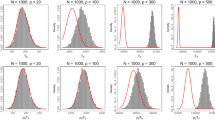Abstract
Based on the usual factor analysis model, this paper investigates the relationship between improper solutions and the number of factors, and discusses the properties of the noniterative estimation method of Ihara and Kano in exploratory factor analysis. The consistency of the Ihara and Kano estimator is shown to hold even for an overestimated number of factors, which provides a theoretical basis for the rare occurrence of improper solutions and for a new method of choosing the number of factors. The comparative study of their estimator and that based on maximum likelihood is carried out by a Monte Carlo experiment.
Similar content being viewed by others
References
Akaike, H. (1974). A new look at the statistical model identification.IEEE Transactions on Automatic Control, AC-19, 716–723.
Akaike, H. (1987). Factor analysis and AIC.Psychometrika, 52, 317–332.
Anderson, T. W. (1984).An introduction to multivariate statistical analysis (2nd ed.). New York: Wiley.
Anderson, J. C., & Gerbing, D. W. (1984). The effect of sampling error on convergence, improper solutions, and goodness-of-fit indices for maximum likelihood confirmatory factor analysis.Psychometrika, 49, 155–173.
Anderson, T. W., & Rubin, H. (1956). Statistical inference in factor analysis.Proceedings of the Third Berkeley Symposium on Mathematical Statistics and Probability, Vol. 5, (pp. 111–150). Berkeley: University of California Press.
Bechtoldt, H. P. (1961). An empirical study of the factor analysis stability hypthesis.Psychometrika, 26, 405–432.
Betler, P. M., & Dijkstra, T. (1985). Efficient estimation via linearization in structural models. In P. R. Krishnaiah (Ed.),Multivariate analysis VI (pp. 9–42), Amsterdam: North-Holland.
Boomsma, A. (1985). Nonconvergence, improper solutions, and starting values in LISREL maximum likelihood estimation.Psychometrika, 50, 229–242.
Browne, M. W. (1982). Covariance structures. In D. M. Hawkins (Ed.),Topics in applied multivariate annalysis (pp. 72–141). Cambridge: Cambridge University Press.
Davis, F. B. (1944). Fundamental factors of comprehension in reading.Psychometrika, 9, 185–197.
Emmett, W. G. (1949). Factor analysis by Lawley's method of maximum likelihood.British Journal of Psychology, Statistical Section, 2, 90–97.
Hägglund, G. (1982). Factor analysis by instrumental variables methods.Psychometrika, 47, 209–222.
Hakstian, A. R., & Muller, V. J. (1973). Some notes on the number of factors problem.Multivariate Behavioral Research, 8, 461–475.
Hakstian, A. R., Rogers, W. T., & Cattell, R. B. (1982). The behavior of number-of-factors rules with simulated data.Multivariate Behavioral Research, 17, 193–219.
Harman, H. H. (1976).Modern factor analysis (3rd ed.). Chicago: University of Chicago Press.
hemmerle, W. J. (1965). Obtaining maximum-likelihood estimates of factor loadings and communalities using as easily implemented iterative computer procedure.Psychometrika, 30, 291–302.
Holzinger, K. J., & Swineford, F. (1939). A study in factor analysis: The stability of a bi-factor solution.Supplementary Educational Monographs, 48, Chicago: University of Chicago.
Ihara, M., & Kano, Y. (1986). A new estimator of the uniqueness in factor analysis.Psychometrika, 51, 563–566.
Jennrich, R. I. (1986). A Gauss-Newton algorithm for exploratory factor analysis.Psychometrika, 51, 277–284.
Jennrich, R. I., & Robinson, S. M. (1969). A Newton-Raphson algorithm for maximum likelihood factor analysis.Psychometrika, 34, 111–123.
Jöreskog, K. G. (1967). Some contributions to maximum likelihood factor analysis.Psychometrika, 32, 443–482.
Jöreskog, K. G. (1978). Structural analysis of covariance and correlation matrices.Psychometrika, 43, 443–477.
Kaiser, H. F. (1960). The application of electronic computers to factor analysis.Educational and Psychological Measurement, 20, 141–151.
kano, Y. (1989). A new estimation procedure usingg-inverse matrix in factor analysis.Mathematica Japonica, 34, 43–52.
Kano, Y. (1990). Comparative studies of non-iterative estimators based on Ihara and Kano's method in exploratory factor analysis.Communications in Statistics, Part A, 19.
Kano, Y. (in press). The asymptotic distribution of a non-iterative estimator in exploratory factor analysis.Annals of Statistic.
Lawley, D. N. (1940). The estimation of factor loadings by the method of maximum likelihood.Proceedings of the Royal Society of Edinburgh, Series As,60, 64–82.
Lawley, D. N., & Maxwell, A. E. (1971).Factor analysis as a statistical method (2nd ed.). London: Butterworth.
Lee, S. Y., & Jennrich, R. I. (1979). A study of algorithms for covariance structure analysis with specific comparisons using factor analysis.Psychometrika, 44, 99–113.
Martin, J. K., & McDonald, R. P. (1975). Bayesian estimation in unrestricted factor analysis: A treatment for Heywood cases.Psychometrika, 40, 505–517.
Mattson, A., Olsson, U., & Rosén, M. (1966).The maximum likelihood method in factor analysis with special consideration to the problem of improper solutions (Research Report). Sweden: University of Uppsala, Institute of Statistics.
Maxwell, A. E. (1961). Recent trends in factor analysis.Journal of the Royal Statistical Society, Series A,124, 49–59.
Niki, N. (1980). Machine generation of random numbers.Proceedings of the Institute of Statistical Mathematics, 27, 115–131. (In Japanese)
Okamoto, M. (1988). Early-step estimators in least-squares factor analysis.Mathematica Japonica, 33, 565–576.
Okamoto, M., & Ihara, M. (1984). Partial Gauss-Newton algorithm for least-squares and maximum likelihood methods in factor analysis.Journal of the Japan Statistical Society, 14, 137–144.
Rao, C. R. (1955). Estimationn and tests of significance in factor analysis.Psychometrika, 20, 93–111.
Sato, M. (1987). Pragmatic treatment of improper solution in factor analysis.Annals of the Institute of Statistical Mathematics, Part B, 39, 443–455.
Smith, W. B., & Hocking, R. R. (1972). Wishart variate generator.Applied Statistics, 21, 341–345.
Tumura, Y., & Sato, M. (1981). On the convergence of iterative procedures in factor analysis.TRU Mathematics, 17, 159–168.
van Driel, O. P. (1978). On various causes of improper solutions in maximum likelihood factor analysis.Psychometrika, 43, 225–243.
Author information
Authors and Affiliations
Additional information
The author would like to express his thanks to Masashi Okamoto and Masamori Ihara for helpful comments and to the editor and referees for critically reading the earlier versions and making many valuable suggestions. He also thanks Shigeo Aki for his comments on physical random numbers.
Rights and permissions
About this article
Cite this article
Kano, Y. Noniterative estimation and the choice of the number of factors in exploratory factor analysis. Psychometrika 55, 277–291 (1990). https://doi.org/10.1007/BF02295288
Received:
Revised:
Issue Date:
DOI: https://doi.org/10.1007/BF02295288




